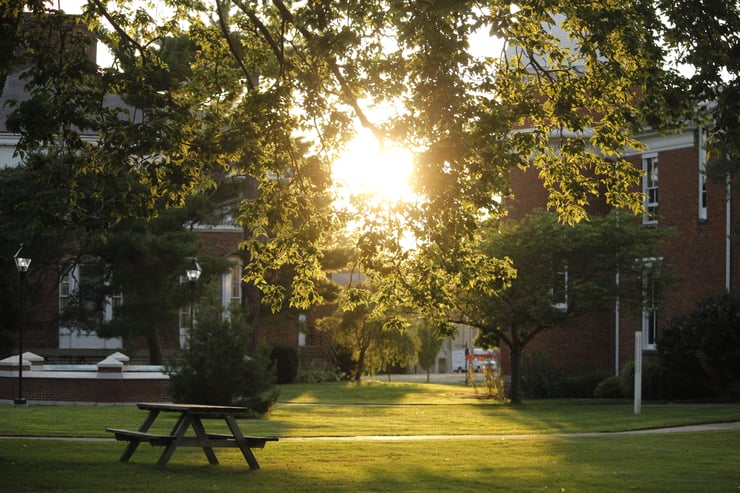I was recently talking with a friend whose 17-year-old son is in the depths of his college-selection process. She related to me her family’s impressions of several campus visits, saying that one school had stuck out because the entire day’s experience—from the information session to the tour to random interactions with students—had reinforced an impressive theme of service. She concluded with a remark about how we all know, however, that higher ed marketing is B.S.
I’ll admit to being a little miffed that my good friend had basically just said that my profession was proliferating B.S. But I had to smile, too, because the story that she had relayed was an example of higher ed branding at its best. She had been captivated by the institution’s consistent delivery of its core ethos—to the point that this university was now her top choice for her son.
It bolstered a point that I always make with clients: staying on message—for the long haul—is critical. Even if you start to get bored with it yourself, it’s important for key audiences who may know of your institution in a general sense but are now interacting with it on a personal level for the first time. But with so much skepticism around college—the admissions process, delivery, outcomes—and just marketing in general, how can you relay your brand in a way that truly connects with cynical parents and their nonplussed teens? How about grouchy alumni and been-there-heard-that donors? While there is no bulletproof solution, I advocate for the following three tenets of branding that can make a difference in how today’s wary stakeholders receive your message.
Build around a relatable theme. So many “about us” statements and marketing materials I see for institutions present a mind-numbing laundry list of attributes and benefits that just end up making the place indistinguishable from its competitors. There’s such a fear of leaving something out that the end result is a run-on sentence of mush.
A recent Fast Company article gave a great example of how a carefully curated brand can provide a better framework for messaging. The article quoted Simon Endres, CEO of Red Antler, the agency that branded Casper mattresses, who said, “With Casper, we worked to say they’re a sleep company, not a mattress company, which gives them flexibility to build content. They can do anything with sleep, or waking life, because the [idea] was that better sleep leads to a better waking life.” The lesson for colleges: You can actually open up possibilities by honing in on an authentic high-level theme and then showing how different aspects of the campus experience support and extend it. Bonus: It’s easier for prospects to remember a singular theme—and make it their own—than to try to memorize a million different facts about your school.
Transcend the transactional. An article last year in Harvard Business Review explored the differences between purchase brands and usage brands. Purchase brands, it says, emphasize promotion, think about what they say to customers, and try to shape what people think about the brand. Usage brands emphasize advocacy, worry about what customers say to each other, and try to influence how people experience the brand—that is, they “think of customers less as one-time buyers and more as … members with an ongoing relationship.”
Colleges and universities often act as purchase brands, and that mindset can be hard to shake. But small moves can set change in motion. Engaging in social listening can open your eyes to associations both surprising and helpful, as well as identify powerful influencers to leverage. Regular market research is a must; we have some clients that make it a priority to conduct replication studies every two years and closely track the results to gauge brand equity and determine where they need to focus resources. And as my colleague Matt McFadden noted in his November blog post, institutions should think about opportunities where they can shift some traditional marketing activities toward more experiential approaches—programs, events, interactive sites, and other offerings that focus on community-building, customer service, and personalization that positions your brand as a lifestyle choice rather than a negotiable commodity.
Operationalize it. On college campuses, the word “branding” is almost always still paired with “marketing.” The common perception is that branding is the sole purview of the marcomm office. But a handful of colleges and universities are starting to understand the essential role of branding in the institution’s long-term growth. More and more we are seeing brand strategy informing strategic planning, rather than being one of the action items arising from the plan. In terms of best practices, neither is the chicken nor the egg—rather, each is constantly reinforcing and informing the other.
Your brand is not a tagline, logo, and color palette. It is a mission-based expression of your institution’s distinguishing ethos, and its power cannot be taken for granted. The brand promise and values must be taught and consistently nurtured, as noted in a recent Branding Strategy Insider article, which said:
“Brands have so much potential to restore credibility to communications in ways that build the business. … Actions must align to the values of the brand, and customers need to see those values being lived by every worker and in every transaction, internal or external.”
NYU is a good example of a higher ed institution working to operationalize its brand: the university is creating a faculty and staff onboarding center that will provide a one-stop shop for not only handling the logistical components of setting up a new employee—ID badge, health-insurance enrollment, etc.—but also offering training on the institution’s core brand values. From the very start, those who are on the front lines of providing the university experience will understand their role in living and propagating the NYU brand, whether in the classroom or in the dining hall.











